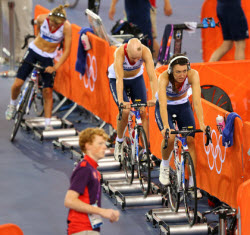
Image from http://www.bristol-cycling.com/
I suppose I should start this by answering your question; "what exactly is their Golden Hour, John?"
It's my description of the 60 minutes, that follows the first 30 minutes, of aerobic activity.
For you, me and many (if not most) of the students in your class, we all have a period of time where we are the strongest on the bike. Depending on your level of fitness, that period could be anywhere between 30 minutes to 3+ hours. It "begins" for most of us after about the first 20-30 minutes of activity.
Now you may be sitting there nodding your head thinking; "yea, that makes sense... I do feel much stronger and capable of higher/longer levels of work, during the second half of class.
Competitive cyclists understand the Golden Hour. If you've watched the Time Trial stages of the Tour De France you've no doubt seen the rows of cyclists on trainers, pedaling through a very specific intensity profile. The picture at the top is of the British Women's Track Cycling Team going through their warm up protocol at last year's Olympics.
I found this at wattbike.com that shows Team Sky's preparation for last year's opening stage Time Trial for the Paris-Nice stage race. The completion of each rider's warm up is timed to coincide with their individual start time of the race.
Paris-Nice
Stage 1 Time Trial
Standard Time Trial Warm-Up
- 5 min light
- 8 min progressive to Zone 5
- 2 min easy
- 2 min to include - 3 x 6s accelerations to activate
- 3 mins easy
Notes:
-
Progressive means building to the power zone over the 8 minutes. Only in the last 1 min do you get to Z5
-
6 second accelerations are sprints & for a whole 6 seconds!
"Why is it an hour?" My perception is that most of our regulars could manage a 90 minute class - if we locked the doors and brought out the whips 🙂 So 30 mins + the Golden Hour = 90 minutes of achievable effort before fatigue sets in.
"But my class is only 45/60 minutes... how would this help?"
I use the Golden Hour to cultivate an abundance mentality mindset in my class. Simply stated; you have a lot... so you can freely spend a lot. A common training technique, for time limited triathletes, is to limit your rides to just double your event distance. So on race day, when you're faced with a 20 mile bike leg, you're thinking; "I'm trained to ride 40 miles - so twenty's no big deal." "I'll have a bunch left for the run."
Contrast this with the scarcity mentality that many of our student's come to class with. They walk in thinking; "I need to pace myself, or I'll never be able to finish this class." Which is the same as saying; I only have a little... so I need to be very careful when and how I spend it. You've no doubt experienced participants who appear to coast through most of class, only to give one big effort at the finish. They were "saving" some of their limited resources, so as not to "run out" before the end.
Here's a few ideas on how you can incorporate the Golden Hour into your classes.
Seek agreement
I talk frequently about the Golden Hour effect at the beginning of my classes, asking for my classes' agreement that they too feel stronger during the second half of class. Then at the 25 minute mark; " do you feel it?" "Do you sense how you body is beginning to fire on all cylinders?" "Do you feel those early feelings of stiffness or limitations/distress in your breathing leaving you?" "Do you have new feelings of strength and confidence?" "Are you ready to take advantage of your Golden Hour?"
Make it a goal to reach the Golden Hour ASAP
It drives me crazy watching people come early to class, mount up and then spend ten or more minutes sitting there slowly turning the pedals. What are they waiting for? I make a point to commend all those making the most productive use of their time in class - and encourage the others who aren't to "get your money's worth" by independently beginning their warm up as soon as possible.
Your participants/students/riders come to your class with different objectives; burn fat, maintain/increase fitness, endorphin rush, etc... Success in any of these requires a commitment to do the work you intended for them. Coaching everyone to work at their potential is part of your role as an Instructor. Helping everyone understand that their capacity for work exceeds the length of available class time, can go a long way toward helping everyone reach their unique fitness goals.
Originally posted 2018-06-27 08:51:08.
- ICI Podcast 196 Go Cycle Studio is using the Top Power Display from Performance IQ - December 26, 2025
- You're a Celebrity… act like it! - September 24, 2025
- Lessening the pain of HIIT or Tabata® cycle training - September 18, 2025

